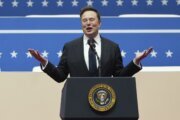The U.S. stock market swung between volatility and chaos as the Nasdaq, and artificial intelligence and semiconductor stocks in particular, plunged amid news that a potentially cheaper and more efficient China-based AI model called DeepSeek had launched.
On Jan. 27, the Nasdaq Composite Index dropped 3.1%, while Magnificent Seven stalwart Nvidia Corp. (ticker: NVDA) shed 17% of its share price and lost about $600 billion in value, breaking the record for a one-day loss by a U.S. company. NVDA stock did rally the next day, as retail buyers “bought the dip.” NVDA shares ended the day up 8.9%, and the Nasdaq gained 2%.
[Sign up for stock news with our Invested newsletter.]
Wall Street analysts say that one way or another, the technology bubble burst, and the DeepSeek news gave sector investors a reason to shed portfolio shares.
“With the current S&P draw-up already exceeding 30% and valuations approaching stretched levels, history suggests it’s too late to avoid a bust at this point,” Bank of America analysts said in a recent research note.
This week’s tech-stock drain leaves the stock market in a precarious position. Investors must wonder how much risk remains with artificial intelligence stocks while also wondering if they’ll miss out on any significant rebound.
“It’s a mixed picture,” says Stephen Wu, a former AI software engineer at Amazon.com Inc. (AMZN) and founder of Carthage Capital, an options trading firm. “The market was heavily concentrated in AI and tech stocks and performed well. DeepSeek’s breakthrough exposed vulnerabilities in the tech sector, leading to sharp declines in Nvidia and Microsoft.”
One big market problem is that overreliance on a few companies can amplify risk. “Any disruption, like DeepSeek or companies underperforming, could trigger a broader correction,” Wu notes.
Will the market fall into chaos or stabilize quickly? Here are the factors that will dictate whether it crashes or not in 2025:
— A top-heavy market.
— International competition.
— The Fed and interest rates.
— Waning consumer confidence.
— Government overspending.
— Stubborn inflation.
— Economic imbalance.
— More Trump tariffs.
A Top-Heavy Market
As the DeepSeek-triggered sell-off revealed, the market got away with a handful of stocks — notably those Magnificent Seven stocks — generating outsized performance in 2024 and early 2025.
Those seven stocks — Apple Inc. (AAPL), Nvidia, Microsoft Corp. (MSFT), Amazon, Alphabet Inc. (GOOG, GOOGL), Meta Platforms Inc. (META) and Tesla Inc. (TSLA) — recorded more than a 60% average gain in 2024. The Magnificent Seven was responsible for more than half of the S&P 500’s performance in 2024.
“Tech overconcentration is a risk factor,” Wu says. “A select few stocks have driven the majority of market gains, so the market is vulnerable to any disruption.”
International Competition
Related to DeepSeek’s emergence are concerns that there’s a threat to U.S. supremacy as an AI superpower. “DeepSeek’s efficiency with fewer resources challenges U.S. AI leadership,” Wu adds. “That could have long-term implications for tech companies’ revenue and investments.”
As the relationship between the U.S. and China has deteriorated, semiconductors have become entrenched in every aspect of daily life, from smartphones to energy to defense technologies. Since semiconductors support AI in many applications, dominance in this area will play a key role in economic growth, technological development and national security.
The Fed and Interest Rates
Another key risk factor is how the Federal Reserve handles interest rates. The Fed paused interest rate cuts at its policy meeting on Jan. 29, and traders don’t expect another cut until May or June.
“They initially evaluated inflation as transitory, but it’s proven to be sticky,” says Phil Bloyd, an investment advisor with Revolutionary Financial Group in Bluffton, South Carolina. “The Fed tends to take a wait-and-see approach when raising or lowering interest rates. New economic investments should lead to a stable job market, and if government spending slows down, that could also be a positive sign for the markets.”
Waning Consumer Confidence
When shoppers snap their wallets shut, that’s bad news for the stock market.
“Consumer confidence impacts spending, which is crucial for corporate earnings,” says Derrick Fung of New York-based Cardify.
Cardify, which tracks over $70 billion in consumer spending across the U.S., currently sees spending down across every shopping category in retail, travel, consumer discretionary, leisure, and oil and gas this year compared to last year. “Consumers are exercising caution right now,” Fung says.
[READ: 7 High-Return, Low-Risk Investments for Retirees]
Government Overspending
Stock valuations may be high, but there’s an even bigger problem in play — a budget-busting U.S. government spending habit.
According to data from the U.S. Congressional Budget Office, the federal government is staring down a $1.9 trillion deficit for fiscal year 2025. The CBO notes that that’s about 6.2% of the U.S. gross domestic product. “That’s significantly more than the 3.8% that deficits have averaged over the past 50 years,” the CBO notes.
Currently, Uncle Sam is spending more cash than it collects, a scenario that could lead to foreign U.S. Treasury buyers demanding higher interest rates when purchasing American bonds. The situation likely isn’t abating, as the CBO estimates the deficit will rise to $2.7 trillion by 2035.
Stubborn Inflation
The U.S. economy is solid right now, with GDP growth at 3.1% and an unemployment rate of 4.1%, but in economics, looks can be deceiving.
“The biggest issue is inflation running high at 2.9%, which will delay rate cuts along with uncertainty about how the oncoming trade wars will play out,” says Alejandro Zambrano, chief marketing strategist at ThinkMarkets in London. “Moreover, deportation threats, which have already hit the agriculture sector, further increase the risk of higher U.S. inflation.”
Economic Imbalance
Adam Coons, co-chief investment officer at Winthrop Capital Management in Indianapolis, sees market risks in two key areas in 2025.
“Risks to the stock market in the short term are somewhat barbelled,” he says. “On one end, if the consumer remains stronger than expected and inflation kicks back up, the stock market would likely experience some dislocations, which would be driven by the market shifting its expectations that the Fed would no longer be able to cut interest rates further.”
On the other end of the spectrum, stocks would likely falter if employment data and consumer spending were to deteriorate more than expected. “That would be due to the increased possibility of a hard recession and that the Fed waited too long to decrease interest rates,” Coons adds.
More Trump Tariffs
President Donald Trump has made it clear that trade tariffs are a cornerstone of his economic policy.
This is not new for the incoming president, who enacted a tough tariff policy in his first presidential term. That included U.S. tariffs on commodities like steel and aluminum imports. In his second term, Trump said he would push 25% tariffs against Canada and Mexico, along with an additional 10% tariff on China imports.
In January, he issued temporary tariffs against Colombia for not accepting deportees. Once the South American country changed its mind, the Trump administration rescinded the tariff, but it appears that’s a club that the White House will wield if global governments don’t play ball, like it or not.
“President Trump’s potential policies — higher tariffs, tax cuts and immigration restrictions — add further uncertainty, with implications for inflation, trade and fiscal sustainability,” says Michael Ashley Schulman, a financial advisor and chief investment officer at Running Point Capital Advisors in El Segundo, California.
What to Do When the Stock Market Shakes and Quakes
For anxious investors, the best course in turbulent markets is often to remain steady, even when the market is anything but.
“Stock market corrections, typically around 5% to 10%, are a normal and healthy aspect of market cycles,” Fung says. “They present an opportunity to purchase strong companies at more reasonable prices.”
Rather than attempting drastic moves, Fung advises focusing on the long term and considering sectors like technology, consumer goods and export-driven industries. “These sectors are poised to benefit from current trends, such as cooling inflation and a weaker dollar,” he says.
Zambrano says he expects the S&P 500 to keep trending upward as long as it stays above the October 2024 low of 5,679. He says politics will likely play a role, too. “Historically, stocks tend to gain roughly 13% when the Republican Party controls both chambers of Congress and the presidency,” he says. “Therefore, staying long in the market is a good strategy for now.”
That strategy is not one-size-fits-all, however. “Those who need their money in the next two to three years, whether for retirement or buying a home, would be better off moving some of their investments into fixed income to reduce risk,” Zambrano says.
More from U.S. News
How to Invest During Rate Cuts
Is Investing in Renewable Energy a Good Idea? Here’s What Our Experts Say
What Is the Safest Investment With the Highest Return?
Will the Stock Market Crash in 2025? 8 Risk Factors originally appeared on usnews.com
Update 01/29/25: This story was published at an earlier date and has been updated with new information.













